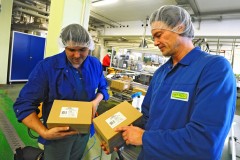HERMA: Linerless labeling at organic food producer Rapunzel
The premium organic brand Rapunzel produces and packs around a half of all its products at its headquarters in Legau in the Allgäu region of southern Germany. Its fastest packaging line now incorporates a HERMA InNo-Liner labeling system, which offers the innovative feature and USP of dispensing entirely with conventional siliconized liner paper. “Some 2,000 to 3,000 labels per shift are applied to secondary packaging for our chickpeas alone, so it’s easy to gage the scale of potential savings,” comments Head of Production Alexander Karst. “This first trial system is already eliminating approximately 355 kg of waste a year. Although we’ve always taken the utmost care when managing this waste, it’s obvious that dispensing with it altogether is a better option.” The HERMA InNo-Liner labeling system is the first practical solution of its kind worldwide that satisfies the high cycle speeds and other demands of modern packaging, distribution and logistics applications in which the direct printing of variable case qualities is ruled out because a satisfactory imprint cannot be assured. It is essential that all codes are clearly and immediately legible in the downstream logistics chain.
Sustainability benefit thanks to process reliability
The system is based on a special adhesive variant and a micro-atomizer that was developed specifically for this material. Not until the label is dispensed is the adhesive activated by precise jets of atomized water. This allows the label material, which is not sticky until it is wetted, to be wound on rolls as normal. Another benefit inherent in the system, according to Karst, is “that the variable data are printed on the label only as it is dispensed. Mix-ups and the incorrect application of labels that have already been printed are ruled out both at the start of a run and in case of interruptions because there are no labels waiting in line or tailbacks – which massively improves process reliability.” And in the absence of a liner, of course, each roll can accommodate many more labels. Handling, warehousing and shipping costs are therefore reduced alongside the savings achieved through the absence of waste disposal. “As far as the application itself is concerned, the InNo-Liner solution also makes better business sense than a normal self-adhesive label,” explains Karst. “But from an operational and functional perspective, the efficient labeling process, the clear imprint and the reliable adhesion are key.” These aspects are important because the secondary packaging label governs the routing of the shipping case throughout its journey. “And the HERMA label sticks very well.” According to HERMA, the self-adhesive solutions specialist, this outcome is achieved within a fraction of a second because the adhesive is applied to the label stock by way of multilayer technology, which it continues resolutely to develop. In addition, the material, print and processing credentials of the HERMA solution remain impressive even at the generally required cycle speed of around twenty A5 or A6 labels a minute. In the final analysis, the system‘s sustainability benefit can be fully harvested only if it offers absolute operating and process reliability. Against this backdrop, Rapunzel insists without reservation that the assimilation of HERMA in its production operation echoes its sustainable principles: “By dispensing with the liner, the HERMA InNo-Liner system is a perfect fit for our approach.”






